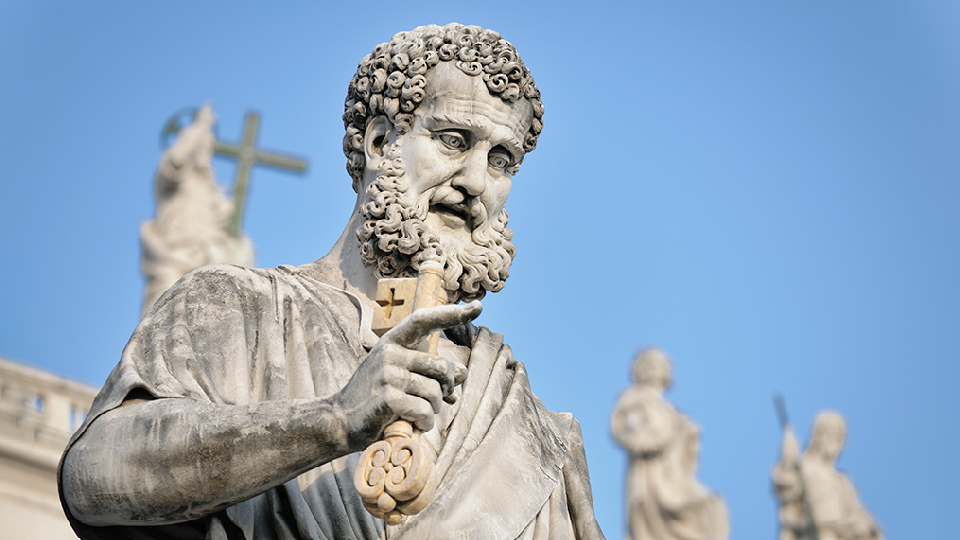

Deacon-structing: What is the One, True Church?
Deacon Pedro
Tuesday, March 28, 2023

Saint Peter the Apostle holding a gold key. iStock Photo.
At a high school reunion shortly after Pope Benedict XVI was elected, I was challenged by a former classmate who is now a United Church Minister. She wanted to understand how, as Prefect for the Congregation (now Dicastery) for the Doctrine of the Faith, Cardinal Ratzinger could have said that “the one true Church is the Catholic Church.” I am not sure which Ratzinger statement she was referring to, but after some research, I am almost certain that this was probably not what he had said. She was likely reacting to something she heard in the news after Ratzinger was elected Pope. Still, at the time, I was at a loss in responding to her because at some level I also thought that the Catholic Church is “the one, true Church.”
 Every week, Deacon Pedro takes a particular topic apart, not so much to explore or explain the subject to its fullness, but rather to provide insights that will deepen our understanding of the subject. And don’t worry, at the end of the day he always puts the pieces back together. There are no limits to deaconstructing: Write to him and ask any questions about the faith or Church teaching: [email protected]
Every week, Deacon Pedro takes a particular topic apart, not so much to explore or explain the subject to its fullness, but rather to provide insights that will deepen our understanding of the subject. And don’t worry, at the end of the day he always puts the pieces back together. There are no limits to deaconstructing: Write to him and ask any questions about the faith or Church teaching: [email protected]
But that is not exactly what the Church teaches.
The idea that the Catholic Church is the “one, true Church” dates back to the time of the Reformation, and seems to be affirmed by Vatican II. However, the Council's Dogmatic Constitution on the Church, Lumen Gentium (LG), uses more nuanced language. In #8 it states that “this one Church of Christ... subsists in the Catholic Church.” The phrase, taken out of context, has been the cause of some division. The Dicastery for the Doctrine of the Faith (DDF) document, Responses to Some Questions Regarding Certain Aspects of The Doctrine on the Church, offers a clear explanation: What is the meaning of the affirmation that the Church of Christ subsists in the Catholic Church? It states thatChrist "established here on earth" only one Church and instituted it as a "visible and spiritual community," (LG #8) that from its beginning and throughout the centuries has always existed and will always exist, and in which alone are found all the elements that Christ himself instituted. (Vatican II Decree on Ecumenism Unitatis Redintegratio, #3, 4) This one Church of Christ, which we confess in the Creed as one, holy, catholic and apostolic […]. This Church, constituted and organised in this world as a society, subsists in the Catholic Church, governed by the successor of Peter and the Bishops in communion with him. (LG #8)Part of the key to understanding the phrase, I believe, lies in the meaning of the word “subsists.” The common understanding is that “to subsist” means merely, “to exist.” However, according to the Oxford Dictionary, the word “subsists” means, “to exist or continue to exist; to keep oneself alive.” In this sense, “the Church of Christ, ‘continues to exist, or keeps herself alive’ in the Catholic Church.” This has a slightly different and less threatening meaning. The DDF “Responses” document explains the word “subsistence”:
In number 8 of Lumen Gentium ‘subsistence’ means this perduring, historical continuity and the permanence of all the elements instituted by Christ in the Catholic Church, in which the Church of Christ is concretely found on this earth.To say that the Church of Christ subsists in the Catholic Church is very different from saying that the Church of Christ is the Catholic Church. I believe that the difference has to do with what “the Church of Christ” really is, which is in fact, what Lumen Gentium is all about.
What is the Church?
The Church is not merely a social, hierarchical, or political institution. She is also not just a set of teachings or beliefs, or a way to live out those beliefs. She is much more than that. Even to say that “we are the Church,” that the “Church is the body of Christ,” or that the “Church is the Bride of Christ” falls short of describing what the Church of Christ really is. LG #8 states that the Church is a visible structure through which Christ communicates truth and grace to everyone. It also states that the mystical or divine Church and the earthly (social, hierarchical, institutional) Church cannot be seen as two separate realities, which is why the Church can be compared to the mystery of the incarnate Word: The social structure of the Church, in building up the “body,” somehow serves the Spirit of Christ, who gives her life. One very clear meaning of all of this is that there is no such thing as “ecclesial relativity”: there is a Church of Christ that continues to exist and keeps herself alive. This implies that Christ did found a Church and that there is, or at least there must have been, a Church of Christ and not an institution that was founded later by his followers. This understanding has been crucial for me when I begin to feel disappointment in the earthly, hierarchical, structural, physical, and temporal aspects of the Church. I am comforted that the Church, while it has those aspects, is also much more than that. The Church is also a divine, spiritual, heavenly, eternal reality that is perfect.Why did Vatican II declare this?
The Second Vatican Council, with Lumen Gentium and its pronouncement that the “Church of Christ...subsists in the Catholic Church,” was addressing the issue of ecclesial relativity. Furthermore, the Council wanted to make clear that Christ did intend to found a Church, and that He did so by gathering the apostles, instituting the Eucharist, and sending the Holy Spirit. The Council also clarified that this Church of Christ still exists in its divine and human fullness today, and the Holy Spirit, despite the weakness and failings of those humans who form part of this Church, continues to guide her and sustain her. Remembering this is also comforting: The Holy Spirit continues to guide and sustain the Church. If we don’t believe and trust this, there is no point in being Catholic. Furthermore, as Lumen Gentium asserts, this Church of Christ is one, unique, and necessary for salvation, for the Church is part of God’s plan for salvation. Christ declared that He is the way to salvation (John 14:6, Acts 4:12) but He also said to Nicodemus (John 3:5) and to His disciples before His ascension (Mark 16:16) that baptism and faith (water and spirit) were necessary for salvation, thus indicating the necessity of the Church for salvation. More basically, Lumen Gentium reminds us that Christ affirmed the necessity of baptism for salvation and since it is the Church that is the minister of Baptism, and it is through Baptism that one enters the Church, we can conclude that Christ Himself pointed to the necessity of the Church for salvation (LG #14). I must say that when I researched this, it was all new to me. I could not accept the wording: “the one true Church is the Catholic Church,” and my experience showed me that God acts as much outside of the Catholic Church, as it does within her. I have had a lot of experience and contact with non-Catholic Christians: I attended an Episcopal school, and my best friend’s dad was the Episcopal Bishop of Panama. My own grandfather was a Baptist, and my wife is baptized in the Anglican Church. The idea that salvation is not available to them does not make sense to me. I know of many non-Catholics who are more saintly than many Catholics I know and, for those who have died, I am certain of their sainthood. At the same time, I understand at some level that the Catholic Church is “one, holy, catholic, and apostolic” and that she is the Church that Christ founded. What I am discovering is that “Church” is not what I presumed all along.Truth and Salvation
Christ left us all that we need for salvation. There’s nothing else. The fullness of what He left is found within the Catholic Church. This does not mean that salvation cannot be found outside of the Catholic Church. The Catholic Church does not claim that she alone possesses the Truth. The Catholic Church teaches that other churches can profess and teach truth, and that the Holy Spirit is working within them. Lumen Gentium #8 clearly states that “many elements of sanctification and of truth are found outside (the Church’s) visible confines.” Over 10 years ago, we aired a program called Common Ground: What Protestants and Catholics Can Learn From Each Other, I remember watching it and being inspired at how Fr. John Riccardo answered all the questions that his friend, Pastor Steve Andrews of Kensington Community Church asked. On this topic, Fr. Riccardo offered the following analogy: Christ left us many tools to help us attain salvation. All the tools can be found inside one large toolbox. Outside this large toolbox there are other smaller toolboxes with some of the same tools, but none other than the large toolbox have all the tools. That large toolbox is the Catholic Church. Of course the reality is a bit more complex. At the same time, it offers insights as to how the Catholic Church relates to other Christian Churches. These are well summarized by the following statement from the DDF document:It is possible, according to Catholic doctrine, to affirm correctly that the Church of Christ is present and operative in the churches and ecclesial Communities not yet fully in communion with the Catholic Church, on account of the elements of sanctification and truth that are present in them (John Paul II, Encyclical Letter Ut unum sint #11). Nevertheless, the word "subsists" can only be attributed to the Catholic Church alone precisely because it refers to the mark of unity that we profess in the symbols of the faith (I believe... in the "one" Church); and this "one" Church subsists in the Catholic Church. (LG #8)
Ecumenism and Inter-Faith Dialogue
While I have always been very clear on the Church’s position regarding ecumenism and inter-faith relations, I’m not entirely sure that when the Church speaks of unity, she really means conversion to Catholicism. What the Church teaches is that all Christians are part of “church.” All Christians are part of the Body of Christ. They may not be in full communion with the Catholic Church, but that doesn’t mean that they are not in partial communion or not part of the “Body.” What’s more, the Vatican II Declaration on the Relation of the Church to non-Christian religions, Nostra Aetate, states in #2 thatthe Catholic Church rejects nothing of what is true and holy in these religions. It has high regard for the manner of life and conduct, the precepts and doctrines which, although differing in many ways from its own teaching, nevertheless often reflect a ray of that truth which enlightens all men and women.This statement reflects what has always been in my heart. I have learned so much about God and holiness from non-Christians. There is much about Truth that we can learn from them and their teachings. Jesus Christ is the Truth. God has reveals Himself to us through His Creation and through His Word. The clearest revelation of God to us is Jesus Christ, His Word-made-flesh. (See John 1) Everything we need for Salvation has already been revealed. Jesus in turn, left us a Church, but His Truth and God’s revelation is not limited to any one church. So, we can say that the Church that Jesus founded is not the Roman Catholic Church. But the Church that Christ founded subsists in the Roman Catholic Church and therefore the Roman Catholic Church, and we who are part of it, must continually strive together with other Christian churches and faith communities, through God’s grace, to become more fully that Church that Jesus founded.
 Every week, Deacon Pedro takes a particular topic apart, not so much to explore or explain the subject to its fullness, but rather to provide insights that will deepen our understanding of the subject. And don’t worry, at the end of the day he always puts the pieces back together. There are no limits to deaconstructing: Write to him and ask any questions about the faith or Church teaching: [email protected]
Every week, Deacon Pedro takes a particular topic apart, not so much to explore or explain the subject to its fullness, but rather to provide insights that will deepen our understanding of the subject. And don’t worry, at the end of the day he always puts the pieces back together. There are no limits to deaconstructing: Write to him and ask any questions about the faith or Church teaching: [email protected]Related Articles:
<<













